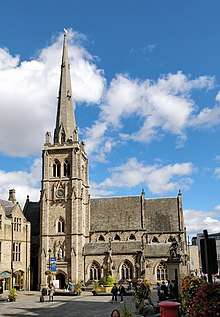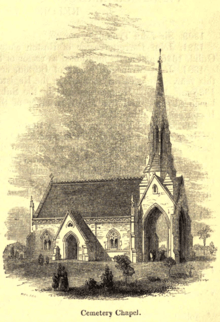James Pigott Pritchett junior
James Pigott Pritchett FRIBA (14 May 1830 – 22 September 1911), known as J P Pritchett junior or J P Pritchett of Darlington, was a British architect.

Biography
Early life
He was born in York, the son of architect James Pigott Pritchett senior (1789 – 1868) and his second wife Caroline Benson.[1] He was educated at St Peter's School, York, before being articled to his father's architectural firm in 1845.[1][2] He travelled in Europe, the Near East and Africa.[1]
Career
In 1854, he succeeded to the architectural practice of his brother-in-law John Middleton in Darlington, where he would continue to work until his retirement.[1][2]

The same year, his father's firm, Pritchett & Sons of York, won a competition to design two chapels, a lodge and entrance gates for the new Boston Cemetery in Lincolnshire, but it was Pritchett junior who attended the meeting in July 1854 and was commissioned to prepare plans.[3] He provided the layout for the grounds and plans for twin chapels and a lodge, all in the gothic style, which were constructed by 1855 when the Anglican chapel was consecrated and the first internment took place.[4] The layout of the cemetery, lodge and Anglican chapel remain intact, though the identical nonconformist chapel was demolished in 1961.[3]
Also in 1854, Pritchett was engaged to renovate the medieval St Nicholas Church, Durham, and when the building was found to be beyond repair he was commissioned to design a replacement.[5] The new church was opened in 1858 and described by the Illustrated London News as "the most beautiful specimen of church architecture in the north of England".[6]
He constructed over 100 more churches and during his career, and was particularly associated with churches in Darlington,[3] although Nikolaus Pevsner believed that St Nicholas Durham remained among his best.[2] He also designed the chapels and lodge at Darlington West Cemetery and around 20 other cemeteries.[3][7]
He was a member of the Archaeological Society of Durham and Northumberland, a founding member of the Northern Architectural Association, and a Fellow of the Royal Institute of British Architects.[3]
His son, Herbert Dewes Pritchett (born 1859) joined him in practice in 1880, and became a partner in 1900.[1]
Death
Pritchett retired around 1910, and died in 1911 at Glendower, Teddington, London.[1] His obituary in the Darlington & Stockton Times referred to him as "an architect of considerable ability".[3] He was buried in Darlington West Cemetery, for which he designed the buildings.[8]
Notable works
- Boston Cemetery, 1855
- St Nicholas Church, Durham, 1858
- St Cuthbert's Church, Darlington (restoration, with George Gilbert Scott), 1864
- St Oswald, Fulford, 1866
- Grange Chapel (now West Park United Reformed Church), Sunderland, 1883[9][10]
References
- Directory of British Architects, 1834-1914. 2. 2001. p. 414.
- Dodds, Derek (2019). Durham City in 50 Buildings. Amberley Books.
- Historic England. "Boston Cemetery Chapel (Grade II) (1391801)". National Heritage List for England. Retrieved 28 Jan 2020.
- Historic England. "Boston Cemetery (Grade II) (1000935)". National Heritage List for England. Retrieved 28 Jan 2020.
- Proud, Keith (29 January 2009). "Lesser jewels that light up cathedral's shadow". The Northern Echo.
- "St Nicholas' Church, Durham". The British Library. Retrieved 28 January 2020.
- Historic England. "West Cemetery, Darlington (Grade II) (1001562)". National Heritage List for England. Retrieved 28 Jan 2020.
- "Guide to West Cemetery in Darlington". About Darlington. Retrieved 28 January 2020.
- Johnson, Michael (2016). Sunderland in 50 Buildings. Amberley Books.
- Historic England. "West Park United Reformed Church, Stockton Road (Grade II) (1207132)". National Heritage List for England.